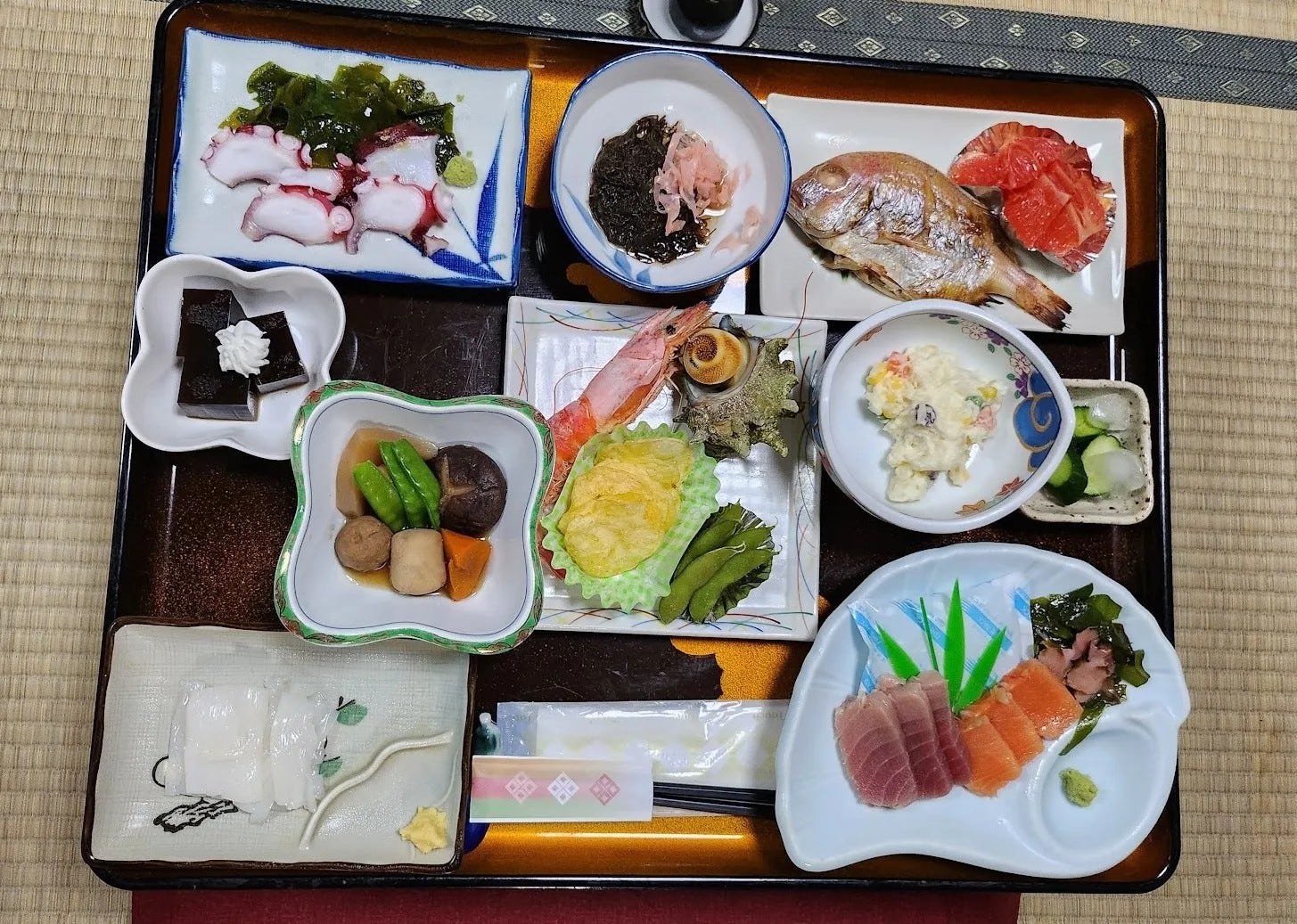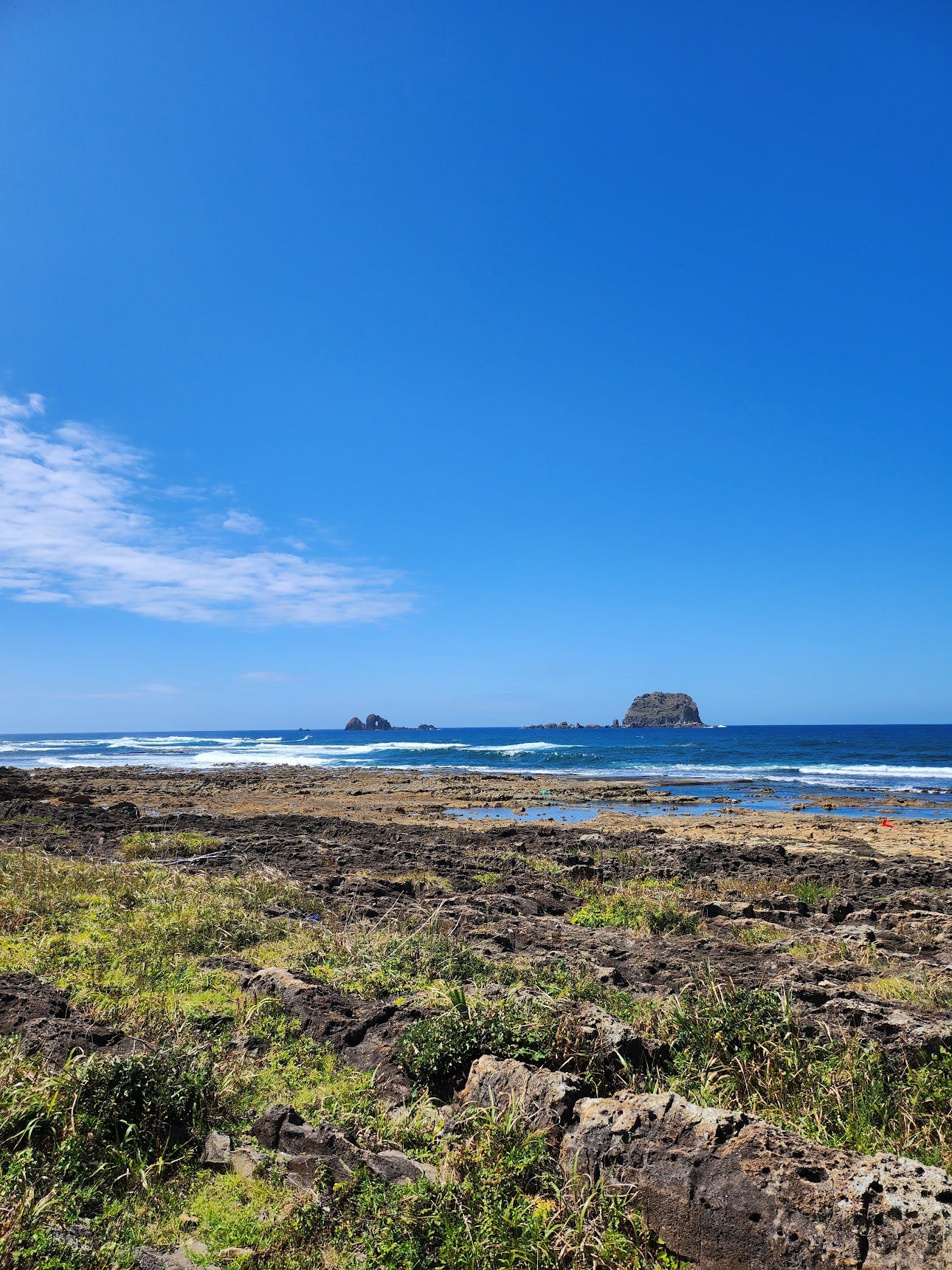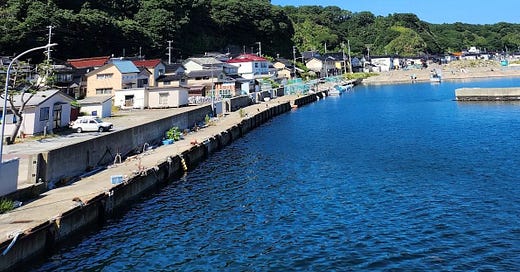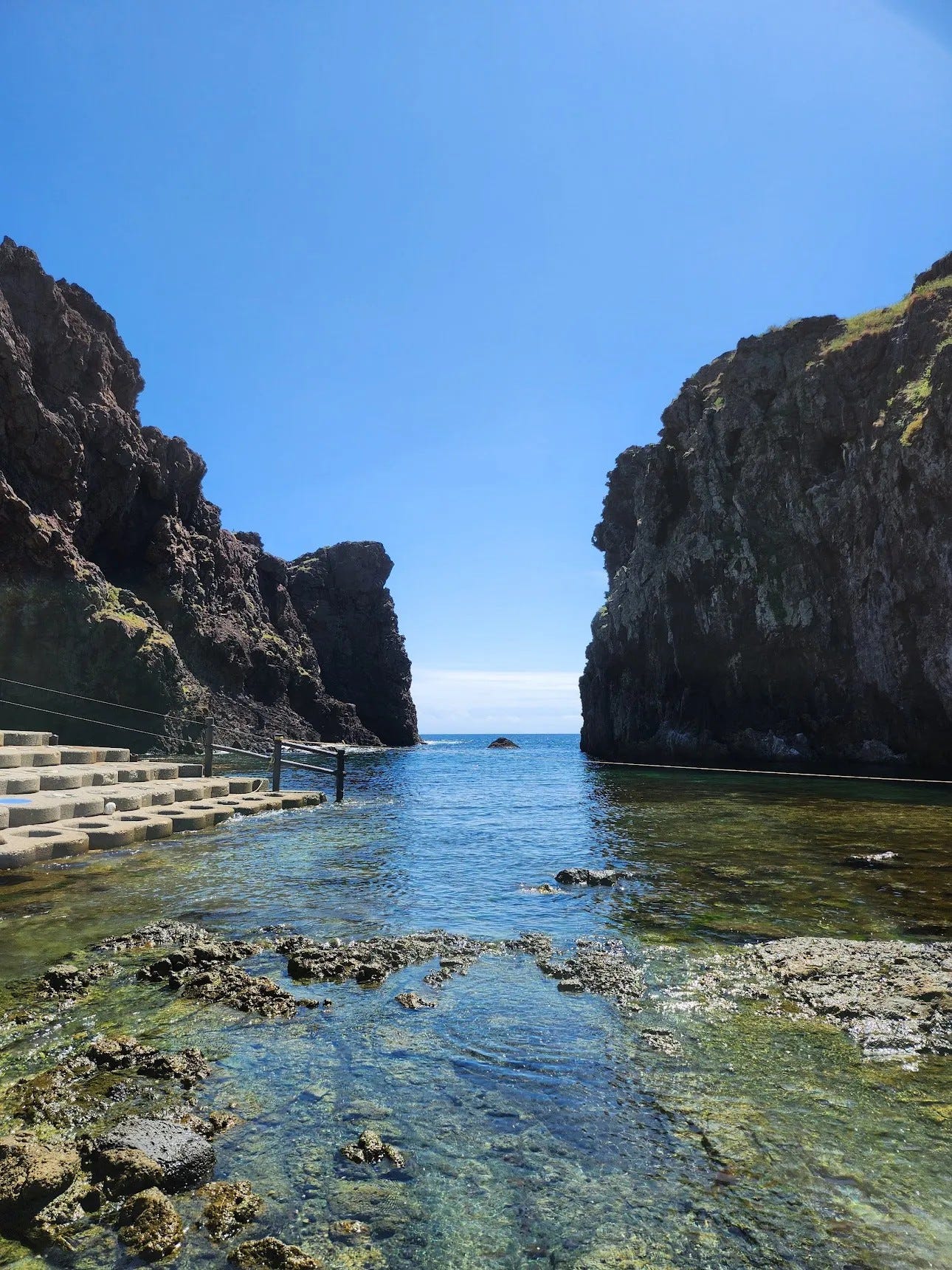The Island of Tobishima: A Slow Travel Gem
An unexpectedly peaceful escape to a rarely visited, depopulating island in the Sea of Japan.
Japan is an island nation of more than 14,000 islands. Only 430 of them are inhabited. The Northeastern prefecture of Yamagata has just one of them. Its name is Tobishima (飛島). In a country where tourists and citizens complain about over-tourism, I am highlighting a place that has not been experiencing over-tourism. When I went, it appeared that my friends and I were the only (foreign) tourists there. I had a special time there, so I thought I would share my story.
The Japanese characters for the name of the island are Tobi (飛), which means flying, and Shima (島), which means island. Interestingly enough, come springtime, this island is an important habitat for migratory birds.
To get to the island, there is a ferry once a day from the port in Sakata City. At the time of writing, the ferry departs Sakata every day at 9:30 with a scheduled arrival of 10:45 am. It costs 4,280 yen for a round-trip ticket, but please consult this ferry’s website for more up-to-date information. Tobishima is a part of the coastal city of Sakata and it is located around 38 kilometers away from the port. The ferry is an important link between Tobishima and the mainland as it brings goods and visitors to the island. My friend remarked that perhaps the important ferry is government subsidized because there did not seem to be many passengers to financially support the ferry. It will likely not be too busy, so secure a seat inside with your belongings and then enjoy the beautiful vista from the rooftop when leaving the mainland and approaching the island.
It is possible to visit Tobishima on a day trip because the ferry arrives at 10:45 a.m. and leaves at 1:45 p.m. This would be a rushed experience but still allows you to see much of the small island on a bike ride. However, my friends and I wanted a more peaceful experience so we stayed overnight at one of the seaside ryokans that support the local community. I noticed that the ryokans average around ¥10,000 per person per night, which is pretty typical for Japan (outside of the major tourist places). This price includes both a delicious locally sourced dinner and breakfast, so I highly recommend that experience too.

For more budget-friendly options, Tobishima has a guest house, but that does not come with meals, and there are not many food options on Tobishima at all. There is one restaurant at the port that is only open for lunchtime, and the “convenience store” located at the store has very limited food options. It is also only open during the daytime. Thus, if you stay at the guest house, bring what you need from the mainland. I recommend having lunch at the port because, again, it is the only place open, and the other meals will be provided at your ryokan.

Tobishima does not have many things to do, but that is the beauty of it. Whenever I go to new places, I usually have a long bucket list of places to go, and then I exhaust myself trying to do all the things. However, in a place like Tobishima, there is no list of places to visit, but there is still much to see. You can enjoy the calm rhythm of island life.
The island provides free bikes for visitors. You will find the bikes near the port. It is a small island, and it is beautiful to just bike around and enjoy the peaceful coastal scenery. The colors are quite vivid in summer and the gentle sea breeze carries the scent of salt and wildflowers as you pedal along the winding paths. We found that it took around 40 minutes to bike around the whole island, but it can take longer than that if you go slow and make frequent stops. You will see many delightful vistas, just like my friends and I did. I recommend finding the cave!
Whenever we encountered a beautiful area, we would park our bikes and explore. I have fond memories of walking along the coastline. By exploring the coastline on foot, the island's dramatic geology will be revealed to you. There are jagged rock formations sculpted over millions of years by the relentless sea and secluded coves with shimmering blue water.

As you cycle, the ghost of the past also reveals itself in the abandoned neighborhoods, silent witnesses to the island's depopulation. Many of the buildings are abandoned, which is not uncommon to see around Japan due to nationwide trends of urban migration and aging populations. The silence of the island is profound, broken only by the rustle of wind through overgrown vines and the distant cry of a seabird. These neighborhoods are this way because not many people live on the island anymore. The population is less than 200 people, and it is an aging population too. The island’s former school building, once filled with the laughter of youth, now stands empty by the seashore.
When staying at a ryokan, after dinner time, there is usually not much to do, but that is the beauty of it. It is possible to truly relax. There are no neon lights, pachinko parlors, or host clubs. After retiring to bed early, you can wake up earlier than normal for sunrise. Riding your bike to a lookout point of the island, you can watch the sunrise. When I awoke early in the morning, many elderly residents were also awake getting ready for the day, which taught me the beauty of getting up early to experience the summer day from dawn to dusk. Watching the dark coastline gradually surrender to the golden rays of sunrise was a breathtaking transformation.
For the best sunrise vista, I recommend going to this lookout point. If you go on a clear day, you will see the sunrise behind Mt. Chokai (鳥海山), the tallest mountain on the coast. Additionally, the water around the island is quite clear. You can see the different colors of water and rock off the coast. The sea air is crisp, the silence profound, the view a breathtaking reminder of the island's enduring beauty.
Snorkeling in Tobishima's protected lagoon is an absolute must, especially during the humid Japanese summer. Close to the port is a protected lagoon where it is easy to enjoy seeing a beautiful variety of fish and sea plants without having to deal with the danger of crashing waves or deep waters. The area is famous for its pufferfish, and you will see many. Make sure to bring your goggles from the mainland, because there is no store or rental shop on the small island. I thoroughly enjoyed snorkeling with my friends, immersed in this silent, colorful world, where we were the only observers.
Tobishima also has beautiful hiking where it is possible to see the ragged and rocky coastline that surrounds the island. I will never forget the beautiful coastal vistas we saw where the color contrast between the green of the plants and the deep azure blue of the sea were heightened by the summer season. And again, there was no one else there!

Another “attraction” of Tobishima is its felines. Japan has numerous “cat islands” that draw tourists to come and interact with the feline populations that have come to outnumber human residences. There are notable ones in both Fukuoka and Miyagi. However, Tobishima also has a large cat population! We did not know this until we arrived, but then it was impossible to ignore, as we came across many cats during our stay here. If you are interested in cats, you can avoid having to make a reservation at a busy cat cafe in Tokyo or the other touristy cat islands and come interact with them here.
As you enter a Japanese restaurant or onsen, you will usually be greeted by the staff with the phrase “ごゆっくり” (goyukkuri), which means “to enjoy slowly or at one’s leisure.” Here, on Tobishima, this phrase takes on a deeper meaning. Unlike the hurried pace of a Tokyo cafe or the crowded streets of Kyoto, time slows to a gentle crawl. The island invites you to savor each moment, to breathe in the salty air, to listen to the waves, to simply be.
Overall, Tobishima was a memorable, peaceful, and delightful experience. Unlike other destinations in Japan, there were no chaotic crowds, no rush to complete a long checklist of sights, and no preconceived expectations of what to experience. When you travel with a detailed plan, you do not truly slow down to experience the place. I do not mean to downplay this type of travel, as I have visited innumerable places where I rush around to experience as much as I can in a short time. It is thrilling and fun, but it is also stressful! Tobishima remains such a memorable trip for me because I experienced the opposite. It was possible to slow down, as there was no other choice. It opened up a new possibility of travel for me. A possibility of reveling in slow travel.
Since the island is dealing with depopulation, if visitors do not continue to visit, the already limited hospitality infrastructure such as the ryokans and the daily ferry will likely also cease to exist. That is why I have become an advocate for the island. By visiting the island, visitors can continue to its sustainable future and ensure that this hidden gem can stay afloat.
Thank you for reading about my time on Tobishima. I plan to revisit it again this summer. I hope that you will add this island to your list of future destinations. If you are not able to, I hope that this blog will encourage you to seek out more slow travel experiences in your life. Tobishima is a reminder that there is beauty to be found in simplicity, and that travel should not only be about checklists.












Complaints about so-called "over-tourism" baffle me. Don't they mean "mis-management of tourism while looking a gift horse in the mouth"? As your blog shows us, Japan is a large and very beautiful country. It also has a very weak economy and a very weak currency. In 2024, 37 million foreign tourists visited Japan, and 99% of them tried to squeeze into Tokyo, Kyoto and maybe Osaka, resulting in complaints of so-called "over-tourism," damaging Japan's brand overseas and creating tensions within Japan. Surely this is failure and incompetence on a monumental scale, the squandering of an opportunity of which most countries can only dream? Where is tourism-industry leadership? I throw my hands up in despair :(
This looks like a beautiful place with plenty to do: walking or hiking, poking around, cycling, gazing at gorgeous views. Thank you for this detailed visit!